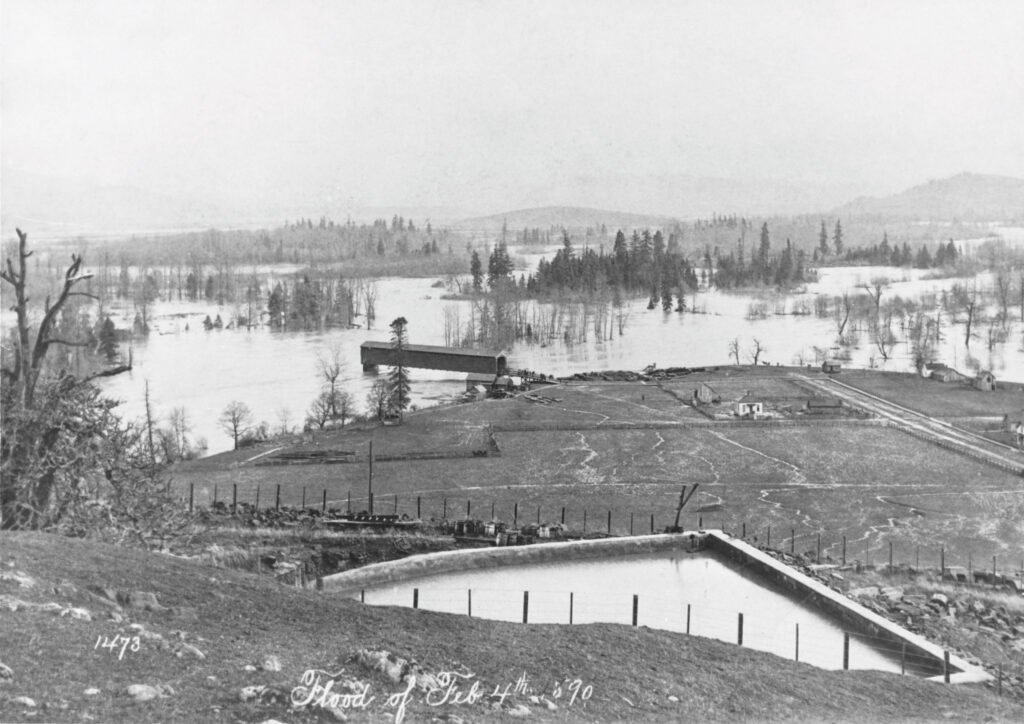Area gets a major flood, first UO football victory

1887-1897
By Mark Baker
For The Register-Guard
“City” disappeared from Eugene’s name in 1889, but the Guard continued calling its weekly Saturday edition The Eugene City Guard until 1899, even after launching its “Daily Eugene Guard” edition, which was published Monday through Friday, in June 1891.
Its weekly edition ran through the first decade of the 20th century, changing its name to Eugene Weekly Guard sometime in 1899.

By 1890, Eugene’s population had almost tripled since 1880, going from 1,117 to 2,958, while Springfield had 371 residents in 1890, and Lane County had swelled to 15,198.
And many of them were affected by one of the biggest stories of the decade, the flood of early February 1890.
“The 1890 Flood!” read the one-column headline on Page 3 of the Feb. 8, 1890, issue of The Eugene City Guard.
“Highest Water Since 1861 – Lane County Loses $10,000 in Roads and Bridges – No Trains or Mails for 7 Days – Heavy Losses in Lower Valley,” read the subhead.
In addition to the usual half page or more of advertisements, the Feb. 8, 1890, front page contained two columns about the U.S. Army Corps of Engineers’ proposal to build two high-tide stone jetties – estimated cost, $280,190 – on the Siuslaw River and Bar at the Oregon Coast.
Ironic, because the Feb. 15 issue would carry more details about the devastation of the flood – the fourth massive flood to hit the area, and most of Western Oregon, since 1851 – including the deaths of four people along the Siuslaw; two of them, a sister, 20, and brother, 12, of the Andrews family.
“An immense amount of earth, timber and stone came from the hill above their home knocking the house to pieces and burying the unfortunate persons beneath the debris,” the Feb. 15 report said. “Mr. Andrews and a son by some strange chance were carried into the river clinging to a log down 10 miles before they were rescued from their perilous condition.”
The Feb. 8 issue of the still-weekly Guard detailed damage caused by the heavy rains and wind that began on a Tuesday, Jan. 28, and didn’t cease until the following Tuesday, Feb. 4. The floodwaters of the Willamette River rose high around the 14-year-old, wooden Ferry Street Bridge, as seen in photographs of the day taken from Skinner Butte.

The flood of 1890 didn’t equal the destruction of the great flood of December 1861 and January 1862. Considered the worst flood in Oregon, California and Nevada history, that flood caused much death and destruction, washed horses away in Lane County and had the Willamette River cresting as high as 25 feet above the low-water mark. Skiffs rowed through Willamette Street in Eugene City.
The Guard’s reporting of the 1890 flood told of the Willamette River cresting at 22 feet, 1 inch, and how miles of fencing were washed out. Damage was estimated at $100,000 in Lane County, the equivalent of $2.5 million in 2017 dollars.
Also destroyed in the 1890 flood was the Springfield bridge over the Willamette, then the largest and most expensive in the county, built for $14,275 in 1881 after that year’s flood destroyed the previous bridge.
From the dead-serious to the seriously disillusioned, the Guard reported a story in the spring of 1891, a month before it became a daily, on a no-show presidential visit.
“An Insult to Eugene,” read a headline in the May 9, 1891, Eugene City Guard.
“President’s Train Stops 20 Minutes – Benjamin Does Not Appear – The Citizens Indignant at the Affront,” read the subhead.
“Benjamin” was Benjamin Harrison, the nation’s 23rd president, who made a stop in Eugene on May 5, 1891, on his way to Portland from San Francisco during a West Coast tour. But he never stepped onto the train’s platform during the 6:10 a.m. stop – speculation being that he was asleep in his car – despite a large turnout of 2,000 and a reception committee that included Mayor John McClung, Eugene City Register publisher Silas Yoran, and prominent businessman Sam Friendly.
During the stop, a McKenzie River fishing party delivered “a basket of as fine trout as ever was lifted from the water,” the Guard reported.
Later that day, an irate greeter sent a telegram to Harrison in Portland:
EUGENE, May 5 – Send back the basket of trout and we will send suckers instead.”
– INDIGNANT EUGENE
The Register, run by Yoran’s sons Will and George after their father left to run a shoe store and work as a bank vice president, went daily in 1895 and sold that same year to C.J. Rowlands, Howard Rowlands and L.S. Howard, three Eugene printers who knew little about journalism, Warren Price wrote in his book.
The Register stopped daily publication about a year later, then restarted in 1898.
Something that would be of interest to any University of Oregon football fan ran at the bottom of the front page of the Daily Eugene Guard on March 26, 1894, two days after the UO played its first-ever game:
“A BAD GUESS,” the headline read. “Saturday afternoon’s Albany Democrat says: ‘The college football team went to Eugene last night and were to play the university team then at 3 o’clock. The Guard gives the average weight of the varsity eleven at 167 lb. and that of Albany College at 147, a difference of 20 lb. It is the man-about-town’s opinion that the Albany team will win.”
Oregon won the game, played at Kincaid Field next to Deady Hall, 44-2, thus the “Bad Guess” headline. There was no other coverage of the game in that day’s issue, and the small note did not mention the score. Perhaps, in a town that was then about 3,000 in population, what happened two days before on Saturday, March 24, was old news?
The UO was coached by 22-year-old Cal Young, who was born in a log cabin in Eugene in 1871.
Mark Baker, who researched and wrote the stories for this special section, is a former Register-Guard reporter and a member of the third generation of the Baker family.

Mark Baker has been a journalist for the past 25 years. He’s currently the sports editor at The Jackson Hole News & Guide in Jackson, Wyo.
